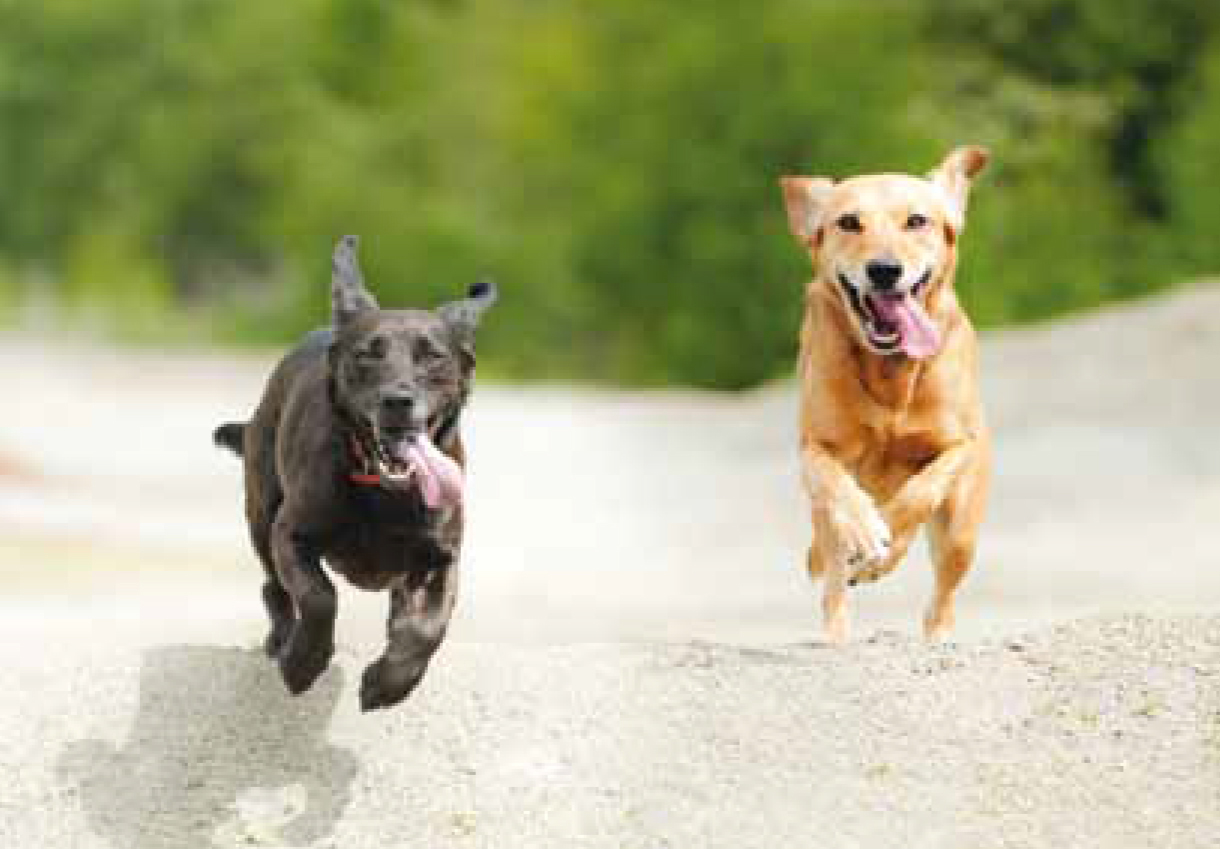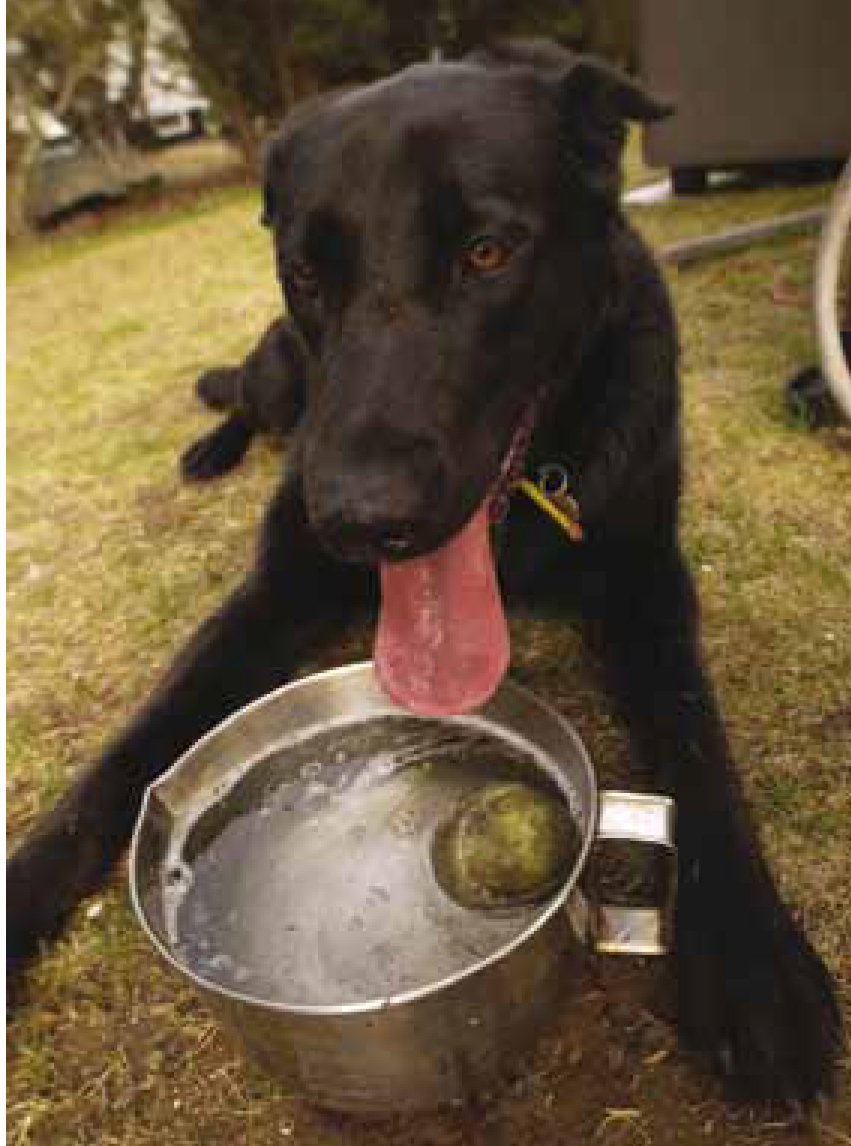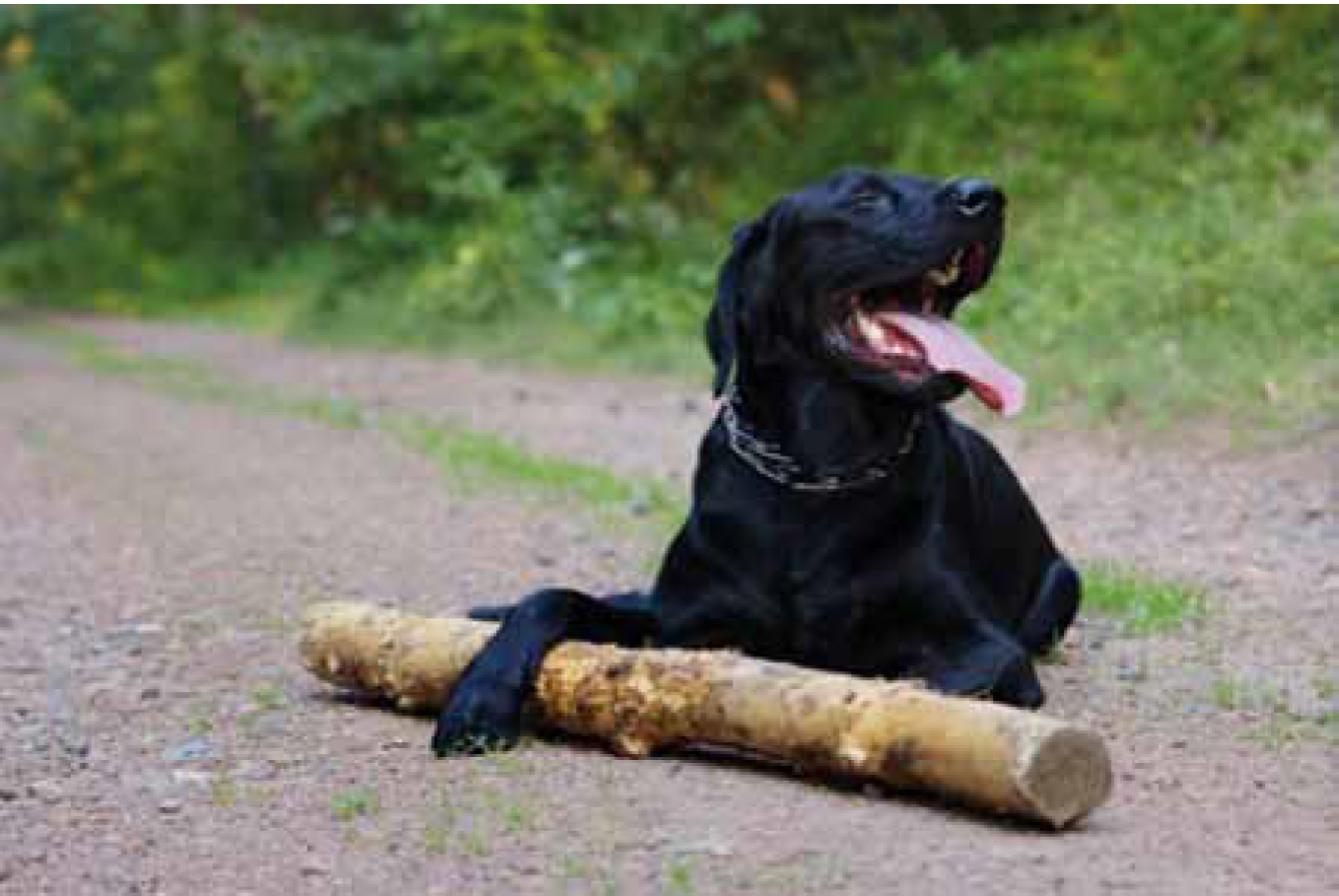Knowing the physiology behind thermo-regulation of a dog is a key factor in nursing cases of canine hyperthermia at any time, but especially during warm days.
Hyperthermia is an increase in normal body temperature, the normal value for dogs being 38.0°C to 39.0°C (Jack and Watson, 2003). It occurs when heat production is such that it overwhelms the body's ability to reduce body temperature, and can be distinguished from pyrexia. Hyperthermia may be associated with increased respiratory rate, tachycardia, panting, warm skin, dry or tacky mucous membranes, which may turn a dark brick red in colour, altered laboratory values(electrolyte imbalance, metabolic acidosis, increased packed cell volume(PCV) due to dehydration), seizures or convulsions, and changes in level of consciousness(LOC)(Rockett, 2009). Hyperthermia can range from low grade pyrexia (fever) to a life-threatening condition.
Causes of hyperthermia in dogs
Hyperthermia in dogs, which is most common during the summer months, can be caused by a number of things. Risk factors for developing heatstroke include age extremes, thick haircoat, and prior history of heat-related illness, with a predisposition in giant and brachycephalic breeds(such as pugs, bulldogs etc)(Tilley and Smith, 2000). Brachycephalic breeds are more predisposed to overheating, as their face shape makes it more difficult for the dog to cool down by panting(Canine Health Foundation, 2012).
Overweight or obese dogs have difficulty cooling down, and will overheat more quickly, especially when suffering from exercise-induced hyperthermia(Ettinger and Feldman, 2000; Bruchim et al, 2006). The resting heart rate of an overweight or obese dog is higher than one that is leaner (Hand and Novotny, 2002).
Exercise during hot and/or humid weather condition, in fact any activity that raises the heart rate (playing fetch, walking and swimming) can all potentially cause hyperthermia in the dog (Figure 1.). It is important that clients are educated to watch children playing with dogs during hot weather, as children are not likely to recognize that the dog is becoming overheated.

Leaving a dog in a car on a hot or humid day is a primary cause of hyperthermia and death. The internal temperature of a car can shoot up to in excess of 50°C in 10 minutes (Manning and Ewing, 2009). Leaving open the window does not make any palpable difference to the interior temperature (Gosline, 2005). In addition, a human study carried out in the US showed that even at relatively cool ambient temperatures, the temperature rise in vehicles is significant on clear, sunny days and puts infants at risk for hyperthermia (McLaren et al, 2005). In the same way, animals left in cars would be at risk. The study found that ‘vehicles heat up rapidly, with the majority of the temperature rise occurring within the first 15 to 30 minutes. Leaving the windows opened slightly does not significantly slow the heating process or decrease the maximum temperature attained’ (McLaren et al, 2005). Owner education to this effect is vital to reduce cases of car-induced hyperthermia.
A retrosepctive study of 42 dogs in the US presented with heat-induced hyperthermia, showed that 31 of these had occured before July (Drobatz and Macintire, 1996). Another indication that heatstroke is not confined to the hotter summer months.
A kennel or exercise area with inadequate shade can also be a risk for hyperthermia. Housing a dog in an area without adequate shelter is not only inhumane, in many countries it is also illegal. Sufficient water is essential in all kennelling areas, and lack of water can be a risk factor to developing heatstroke.
Some toxins and poisons can cause the body temperature to rise rapidly. Examples include some herbicides, some species of snake bite, and accidental poisoning with methamphetamines (e.g. speed), cocaine and other stimulants. Veterinarian diagnosis and a full clinical history are essential to ensure any underlying causes other than heat are also identified and treated accordingly.
Pyrexia or fever which elevates the body's core temperature often occurs as the animal's response to infection, (e.g. septicaemia) and in severe cases this can lead to acute hyperthermia, but the mechanism here is distinct from heatstroke as pyrexia affects the hypothalamic set point.
Obtaining a patient history as quickly as possible after the patient is presented is critical in producing a care plan for the hyperthermic patient, so not only can symptomatic treatment be employed, but also the underlying cause addressed, particularly if the cause of the raised temperature is disease or toxin orientated. This article will focus on heat-induced hyperthermia.
Responses to increased body temperature
The body of a dog will produce heat when they work, play or are confined in a hot situation (e.g. in a parked car or unsheltered kennel). Dogs have several mechanisms for moderating body temperature and getting rid of excessive heat.
The most important mechanism of dealing with excess heat is breathing out some of the heat through respiration. Panting is the key method of dealing with heat in dogs, however, it is not a very effective method when the temperature increases, especially if the dog is also exercising. Excessive panting can lead to respiratory distress. As mentioned above, brachycephalic dogs in particular are quite ineffective at cooling using panting.
Another cooling mechanism is evaporation. Dogs only sweat a small amount from their paws, which is not an efficient way of cooling. In addition, the process is hindered if the dog is being kept on hot concrete or walking down a hot sandy beach.
Additionally, some heat is lost through convection/radiation where heat is moved directly from the skin to the environment. In thick-coated dogs this is very difficult, as it is for dogs in a hot environment, such as a hot car or in blazing sunshine.
Client education
Keeping the above mechanisms in mind, there are several things that clients can be advised to help prevent hyperthermia in dogs. A fact sheet or short article in the clinic website or newsletter can be very useful in client education, and as a reminder to clients to exercise caution in sunny weather.
Some of the more critical points include:


Signs of heatstroke
There are a number of clinical signs of heatstroke. A dog may be presented with some or all of them (Box 1). First aid in cooling the dog through means mentioned above needs to be administered as soon as possible to prevent the body temperature continuing to rise.
If the dog does not seem to be making an improvement after 20 minutes, it should be taken, in a cooled vehicle, to the veterinary clinic where cooling treatment can continue. The veterinary clinic will have better resources on hand to deal with the emergency, and can monitor the animal in more detail.
People who are providing first aid to hyperthermic dogs often forget to cool the car down in their haste to get the dog to a veterinary clinic for treatment. It is important the first aid provider takes a moment to think about the temperature of the car when the door is opened on a hot summer's day. Putting a compromised dog straight into a hot vehicle will aggravate the condition of the dog, and make its body temperature quickly rise again to a dangerous level. Because the dog is already in a poor condition, travelling it in a hot car could lead to the dog quickly deteriorating, and may lead to a recovering dog collapsing. Run the car with air conditioning cooling system on full or windows down while continuing to administer first aid to the dog until the temperature of the car has been adequately reduced.
If possible have someone continue to cool the dog with wet towels turned regularly while someone else drives to the clinic.
Veterinary nurse intervention
Obtain patient history
What happened to trigger the event? In a dog that has overheated without apparent exposure to excess heat, an assumption that the hyperthermia was triggered by over exertion may lead to disease or toxicity being missed as the cause, and subsequent relevant treatment being delayed. Knowing a brief of the dogs signalment and previous history/current medications etc can be useful for the veterinarian to make informed diagnoses and can save valuable time.
Monitoring
Monitor and record temperature, pulse rate and character, respiration rate and character, capillary refill time (CRT), mucous membrane colour, and LOC.
The frequency of monitoring will be ordered by the veterinarian, and is dependent on the severity of the case. Trending of these parameters over time will indicate whether the animal is responding to treatment.
Extreme hyperthermia is a veterinary emergency; the veterinarian needs to be immediately notified if the core temperature is above 40°C.
Provide a cool environment for the patient
Treat the patient in a cool environment, and use fans to help circulate the air. Use runningwater or soaked cloth/towels where running water is not appropriate, to help cool the dog down in the recumbent patient. Apply these to the groin and throat areas on the patient, and have several on hand so they can be changed for fresh ones as they warm up.
Avoid immersing the dog in cold water. Running luke-warm water over the animal is the best option. Cooling the dog with alcohol bathes is also an efficient method that prevents over cooling. Aim to gradually cool the patient to 39.5°C (Jack and Watson, 2003).
Provide supplementary oxygen as ordered by the veterinarian
Excessive panting and heat-induced respiratory distress results in an increased demand for oxygen. Animals that require more than 30 minutes of oxygen therapy should receive humidified oxygen.
Respiratory alkalosis may arise from excessive panting, and causes a greater than normal loss of carbon dioxide from the body, although this is uncommon.
Monitor fluid intake and loss
Monitor fluid intake and provide fluids at a rate and route as ordered by the veterinarian. If oral fluids are administered, ensure the volume consumed by the patient is recorded. Watch for vomiting or regurgitation, especially if too much is consumed too quickly.
Record colour and volume of urinary output, and volume of any vomit. Hyperthermia may cause dehydration, which results in anuria or obliguria (reduced, concentrated and very dark urine or no urinary output at all), for a few hours.
Obtain laboratory samples, as requested by the veterinarian
Once the dog reaches the veterinary clinic, the veterinarian may decide to draw blood samples to determine the causes and effects of the hyperthermia. Common tests performed include complete blood count (CBC), blood chemistry profiles, electrolyte levels, serum titres and urinalysis.
As the patient responds to treatment, the values of the laboratory tests run will show a trend towards normal values.
Administer medications as ordered by the veterinarian
The veterinarian may administer diazepam if the dog is in acute respiratory distress from hyperthermia. Signs of this are bulging eyes and rapid, forced panting. The dog appears to be frantic, but incapable, of taking in enough air. The drug diazepam is used to relax the muscles and calm the patient, and is also a common treatment for seizuring patients. Reducing a patient's ability to pant when it is overheated means it will need careful monitoring.
Other common medications prescribed for hyperthermia include antipyretics, electrolytes, corticosteroids (prednisone), and perhaps antibiotics, depending on the cause of the hyperthermia (Adams, 1999).
Critical nursing
Intensive care personnel must pay particular attention to the airway, reduce the temperature, limit the production of heat, optimize circulation, and monitor for and treat any arising complications, such as impaired hepatic or renal function.
The goal of treatment is to reduce the temperature by at least 0.2°C/min to approximately 39°C. Active external cooling generally is halted at 39°C to prevent overshooting, which can result in iatrogenic or rebound hypothermia(Wingfield and Raffe, 2002).
A comfortable cage with cotton sheeting or similar as its base bedding should be prepared. The cotton under the dog will help stabilize the temperature without overheating the dog, and a woollen blanket can be placed over the dog once its temperature has returned to normal to help prevent over cooling.
Along with vital signs(heart rate and character, respiration rate and character, rectal temperature, mucous membrane colour and capillary refill time), the demeanour of the dog should be noted. A dog returning to good health will become more alert and responsive. It may appear slightly lethargic or tired, but this is normal post hyperthermia. The veterinarian may want to keep the dog hospitalized overnight, in which case the ‘ins and outs’(food and water consumption, and urinary, faecal and vomit output) need to be recorded.
Post hyperthermia care
Consequences of hyperthermia or heatstroke can include renal failure, seizures, tachycardia and spontaneous bleeding which may occur hours or days after the event. With this in mind clients should be advised to fully rest dogs that experience hyperthermia for 10 days before slowly being brought back to normal exercise(Eldredge et al, 1997). It should be kept in mind that dogs that experience overheating are more prone to do so again, so it is best prevented in the first place.
Conclusion
Although the severity of hyperthermia does vary in patient according to several factors, every presenting case needs to be treated as a veterinary emergency. The prognosis for dogs that have heatstroke are highly variable and can be good to guarded to grave, depending primarily on how quickly the condition was caught and treated.
